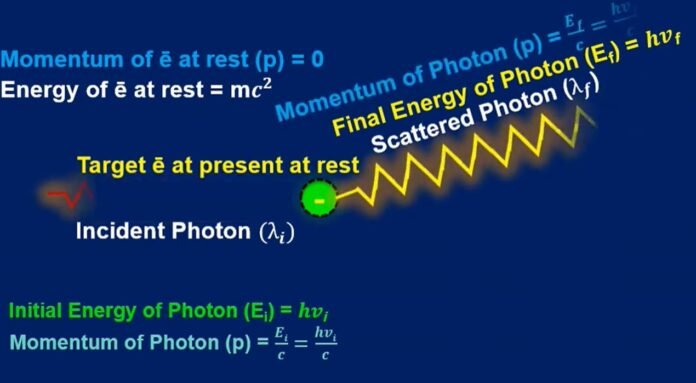Compton wavelength is a concept in quantum physics that deals with the scattering of light by a free electron. When a photon collides with an electron, it may lose some energy and change its wavelength. The wavelength of the scattered photon is called the Compton wavelength and is proportional to the energy lost by the photon in the collision.
Also, Compton wavelength is a fundamental concept in quantum physics that provides insight into the behavior of photons and subatomic particles. It remains an active area of research and continues to play a crucial role in our understanding of the microscopic world.
What is Compton Wavelength?
Compton wavelength is a measure of the interaction between a photon and a free electron, and represents the increase in wavelength of a photon that occurs when it collides with an electron and loses some of its energy. The wavelength change that occurs during this scattering process is known as the Compton wavelength.
Simply the Compton wavelength is a measure of the interaction between a photon and a free electron, and represents the increase in wavelength of a photon that occurs when it collides with an electron and loses some of its energy. Also, compton wavelength provides valuable insight into the particle nature of light, the behavior of electrons and photons, and the interaction between them.
In other words, it describes the wavelength of a photon that has been scattered by a free electron. It is named after the American physicist Arthur Compton, who first described this phenomenon in his studies of X-ray scattering in the early 1920s.
The symbol represents the standard Compton wavelength and the length angstrom(meter) is the SI unit for Compton wavelength.
Compton Wavelength Equation
The Compton wavelength of a particle is defined as the wavelength of a photon that has been scattered by a free electron, and is given by the formula:
where:
is the Compton wavelength measured in meters
is Planck’s constant (
is the mass of the electron measured in gram
is the speed of light (measured in m/s.
This equation represents the relationship between the wavelength of the scattered photon and the energy lost by the photon in the collision with the electron. It shows that as the energy lost by the photon increases, the wavelength of the scattered photon also increases.
Importance of Compton Wavelength
Compton wavelength is important in several areas of physics and is used in the study of quantum field theory, high-energy particle physics, and X-ray diffraction. It is also used to calculate the size of particles, such as electrons and other subatomic particles, that are too small to be directly observed.
Compton Effect
The Compton effect is a phenomenon in quantum physics that describes the scattering of photons by free electrons. That is why, the Compton effect is also known as the Compton scattering.
It was first observed and described by the American physicist Arthur Compton in the early 1920s while studying X-ray scattering. The Compton effect demonstrates the particle nature of light and provides valuable insight into the behavior of photons and electrons.In other words, the Compton effect is defined as the change in wavelength and energy of a photon when it collides with a free electron. The wavelength of the scattered photon increases, and the energy of the photon decreases.
Recommended Articles:
Coherent Sources: Production, Examples, Need and Characteristics
Color of Sunlight: Introduction, Factors, Colors and Effects
Communication Systems: Introduction, Types, Examples And Elements
Compound Lenses Thin Lenses in Contact
Compressive Stress: Introduction, Unit, formula, Dimension And Strength
The Compton wavelength provides valuable insight into the particle nature of light, the behavior of electrons and photons, and the interaction between them. It is a fundamental concept in quantum physics and continues to be an active area of research. Compton scattering is the process by which a photon collides with a free electron and scatters, causing the wavelength of the scattered photon to increase and the energy of the photon to decrease. The wavelength increase that occurs during this process is known as the Compton wavelength. The Compton wavelength has applications in several areas of physics, including X-ray diffraction, high-energy particle physics, and the study of the particle nature of light. The Compton wavelength is unique in that it represents the increase in wavelength of a photon that occurs when it collides with an electron and loses some of its energy in the process. Other wavelengths in physics, such as electromagnetic waves, describe the wavelength of light without taking into account its interactions with matter. The Compton wavelength is directly proportional to the energy lost by a photon in the collision with an electron. As the energy of the photon decreases, the wavelength of the scattered photon increases, and vice versa. Compton Wavelength FAQs
What is the significance of the Compton wavelength in quantum physics?
How does the Compton wavelength relate to Compton scattering?
What are the applications of the Compton wavelength in physics?
How does the Compton wavelength differ from other wavelengths in physics?
What is the relationship between the Compton wavelength and the energy of a photon?
